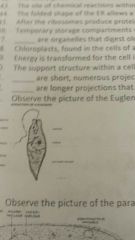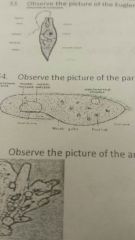![]()
![]()
![]()
Use LEFT and RIGHT arrow keys to navigate between flashcards;
Use UP and DOWN arrow keys to flip the card;
H to show hint;
A reads text to speech;
58 Cards in this Set
- Front
- Back
|
10) biology is the study of____ |
Life |
|
|
11) List the characteristics of life |
Movement, reproduction, sensitivity, nutrition, excretion, respiration, growth |
|
|
12) Put the following in order: Gastrula Zygote Embryo Blastula |
Zygote Blastula Gastrula Embryo |
|
|
13) When does cell differentiation occur |
Why a cell is in a certain location when aa embryo is developing |
|
|
14) the energy required to start a chemical reaction is called ____energy |
Activation |
|
|
15) how does enzyme work |
Increase the rate of the reaction and lowers the energy needed to start the reaction |
|
|
16) the substance an enzyme reacts with is called the _____ |
Substrate |
|
|
17)what do all enzyme usually end with |
-ase |
|
|
18) define diffusion |
Goes down the contraction gradent |
|
|
19) describe the structure of the plasma membrane. What part is hydrophilic? Hydrophobic? |
Phospholipid bilayer heads are hydrophilic and tails are hydrophobic |
|
|
20) who was the first person to see microorganisms using simple microscope |
Van leeuwenhoek |
|
|
21) who looked at cork and termed the word "cells" |
Hooke |
|
|
22) what three parts do cells have |
Plasma membrane, cytoplasm, DNA |
|
|
23) are viruses alive |
No |
|
|
24) if something is a prokaryote it is a________ |
Single celled bacteria |
|
|
25) water is a __molecule because of its unequal distribution of charges |
polar |
|
|
26) ___is the movement of particles from areas of higher to lesser concentration |
Diffusion |
|
|
27) we reach a __ __ when there is continuous movement of particles, but no overall concentration change. |
Dynamic equilibrium |
|
|
28) an ___ is a protein that changes the rate of a chemical reaction |
Enzyme |
|
|
29) we use___ light microscope here at school |
Compound |
|
|
30) they are called compound light microscope because they contain a series of ___ |
Lenses |
|
|
31) the cell theory states: All organisms are composed of one or more__
The cell is the basic unit of ___and organizations or organisms
All cells come from__cells |
A.cell b.life c. Preexisting |
|
|
32) small, specialized structures within cells are called____. |
Organelles |
|
|
33) cells that lack a nucleus and these membrabe-bound organelles are called___ |
Prokaryotes |
|
|
34) those cells that have a nucleus and membrabe-bound organelles are called |
Eukaryotes |
|
|
35) the ___ manages cellular fuction |
Nucleus |
|
|
36) the plasma membrane of a cells exhibits selective__. The membrane ___some molecules to pass through while keeping others___. |
Permeability,allows, out |
|
|
37) aa plasma membrane is composed of ____. |
Cytoplasm |
|
|
38) the plasma membrane is composed of a phospholipids bilayer which has two layers of phospholipid _____ |
Tails |
|
|
39)___proteins move needed substance or waste material threw the plasma membrane |
Transport |
|
|
40) The fuction of the nucleus is to make (,synthesize) ____ |
DNA |
|
|
41) ___are tge sites where cell makes protein according to the directions of___ |
Ribosome DNA |
|
|
42) the clear, gelatinous fluid inside a cell is called__ |
Cytoplasm |
|
|
43) the site of chemical reaction within a cell is called___ |
CBL |
|
|
44) the folded shape of the ER allows a large amount of work to be done in a ___ space |
CBL |
|
|
45) after the ribosome produce protein they transfer them to an organelles called the __ __ which stores then for later use. |
Cbl |
|
|
46) Temporary storage compartments within a cell |
Clb |
|
|
47) ___are organelles that digest old organelles. Food and viruses/ bacteria |
Lysosomes |
|
|
48) Chloroplast found in the cellar of autotropby capture___energy and convert it to ____ energy |
Light/chemical |
|
|
49) energy is transformed fir the cell is its___ |
Mitochondria |
|
|
50) the support structure within a cell is its____ |
Cytoskeleton |
|
|
51) ___are organelles that digest old organelles, food and viruses/bacteria |
Cilia |
|
|
52) ___are longer projections that move a cell with a whip - like motion |
Flagellum |
|

53) observe the picture of the euglena below does it have cilia or a flagellum |
Flagellum |
|

54) observe the picture of the paramecium does it have cilia or a flagellum |
Cilia |
|
|
56)____is the diffion of water |
Osmosis |
|
|
57) when a cell is surrounded by an___ solution, the concentration of dissolved substance in the solution cell is the same as than the concentration of dissolved substance |
Isotonic |
|
|
58) When a cell is bigger then the solution |
Hypotonic |
|
|
59) when a cell is smaller them the solution |
Hypotonic |
|
|
60) type of transportation that requires no energy |
Passive |
|
|
61) sometimes transparent proteins are used to help or "facilitate" the movement of particles threw the plasma membrane. This is referred to as _____ diffusion |
Facilitated |
|
|
62) When you go against the concentration gradient is |
Active transport |
|
|
63) ___ is a process in which a cell takes in food |
Endocytosis |
|
|
64) ___ is a process in which a cell expels waste |
Exocytosis |
|
|
65) as a cell's size increase its ___ increases much faster then it's _____ _____ |
Volume surface area |
|
|
66) for this reason cells ___ because they are too large |
Divide |
|
|
67) cells make ____ tissues make ___ organs make ______ _____ and organ systems compose the ___ |
Tissues ; organs; organ systems ; body |
|
|
68) the ____ of a plant is where photosynthesis occurs |
Leaves |

